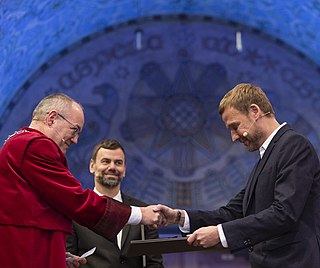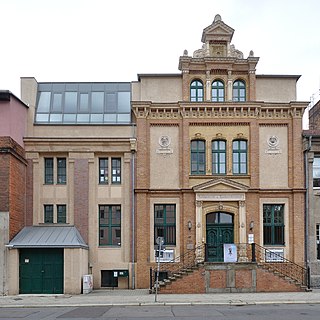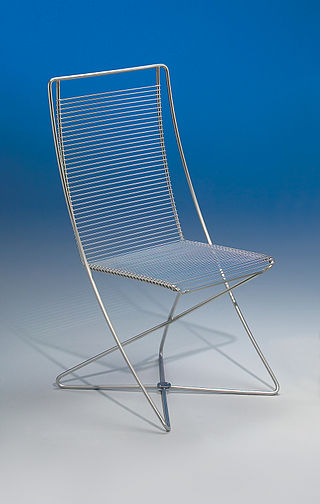Related Research Articles

Friedrich Stowasser, better known by his pseudonym Friedensreich Regentag Dunkelbunt Hundertwasser, was an Austrian visual artist and architect who also worked in the field of environmental protection.

The applied arts are all the arts that apply design and decoration to everyday and essentially practical objects in order to make them aesthetically pleasing. The term is used in distinction to the fine arts, which are those that produce objects with no practical use, whose only purpose is to be beautiful or stimulate the intellect in some way. In practice, the two often overlap. Applied arts largely overlap with decorative arts, and the modern making of applied art is usually called design.

Carsten Nicolai is a German artist, musician and label owner. As a musician he is known under the pseudonym Alva Noto.

The Sacco chair, also called a bean bag chair,beanbag chair, or simply a beanbag, is a large fabric bag, filled with polystyrene beans, designed by Piero Gatti, Cesare Paolini and Franco Teodoro in 1968. The product is an example of an anatomic chair, as the shape of the object is set by the user. “[The Sacco] became one of the icons of the Italian anti-design movement. Its complete flexibility and formlessness made it the perfect antidote to the static formalism of mainstream Italian furniture of the period,” as Penny Spark wrote in Italian Design – 1870 to the Present.
Naum Slutzky was a goldsmith, industrial designer and master craftsman of the Bauhaus. In the art history literature his first name is sometimes spelled as Nahum or Nawn.

Stefan Sagmeister is an Austrian graphic designer, storyteller, and typographer based in New York City. In 1993, Sagmeister founded his company, Sagmeister Inc., to create designs for the music industry. He has designed album covers for Lou Reed, OK Go, The Rolling Stones, David Byrne, Jay Z, Aerosmith, Talking Heads, Brian Eno and Pat Metheny. From 2011 until 2019 he partnered with Jessica Walsh under the name Sagmeister & Walsh Inc.

Michael Elmgreen and Ingar Dragset have worked together as an artist duo since 1995. Their work explores the relationship between art, architecture and design.

A Kunstgewerbeschule was a type of vocational arts school that existed in German-speaking countries from the mid-19th century. The term Werkkunstschule was also used for these schools. From the 1920s and after World War II, most of them either merged into universities or closed, although some continued until the 1970s.

The Museum für Kunst und Gewerbe Hamburg is a museum of fine, applied and decorative arts in Hamburg, Germany. It is located centrally, near the Hauptbahnhof.

The Museum für Angewandte Kunst Köln is a decorative arts museum in Cologne. The collections include jewellery, porcelain, furniture, weaponry and architectural exhibits. Until 1987 it was called the Kunstgewerbemuseum.

The Museum of Applied Arts is a museum in Leipzig, Germany. It is the second oldest museum of decorative arts in the country, founded just six years after the Kunstgewerbemuseum Berlin. Today it is part of the Grassi Museum, an institution which also includes the Museum of Ethnography and the Museum of Musical Instruments, based in a large building on the Johannisplatz.

Kreuzschwinger are seating or lounging furniture. They were invented by the German architect and industrial designer Till Behrens in the 1950s.
Thomas Rusch is a German photographer living in Berlin, Hamburg and Paris.
Kunstgewerbemuseum may refer to:

Vincent Fournier is a French artist and photographer. His works explore questions of science fiction, utopian stories ,and different mythologies of the future such as the space adventure, humanoid robots, utopian architectures, and the technological transformation of the living. His vision is nourished by childhood memories, including visits to the Palais de la Découverte, which evoke the "scientific wonder". While photography remains his preferred medium, 3D printing, video and installations sometimes accompany certain projects. Vincent Fournier's images are put in tension by oppositions that disturb our gaze: reality/fiction, logic/absurdity, past/future, magic/science, natural/artificial. He explores futuristic fiction and discovers in our present, or in the past, "glimpse of the future". After graduating in sociology and visual arts, he studied at the École nationale supérieure de la photographie in Arles and obtained his diploma in 1997.
Michele de Lucchi is an Italian architect and designer.
Giovanni Corvaja is an Italian jewellery artist known for fine wire work.
Max Creutz was a German art historian and curator of the Museum für Angewandte Kunst Köln and the Kaiser-Wilhelm-Museum in Krefeld where he worked from 1922 until his death. In Cologne, in 1914 he was instrumental in the first exhibition of the Deutscher Werkbund, Deutsche Werkbundausstellung. In Krefeld, he succeeded in acquiring modern art exhibits, including works by Max Ernst, Wassily Kandinsky, and Alexej von Jawlensky. He included a substantial collection of art, crafts and design from the Bauhaus.

Maria Cristina Didero is an Italian curator, historian, author, and design scholar. She is curatorial director for Design Miami. Didero is quoted as saying that, "design is all about people, not about chairs."
References
- ↑ Dimaki, Angeliki; Dimakis, Christos E. (May 2006). "From a physical design museum towards a virtual design museum: Or how museology, new technologies and design meet" (PDF). 5th Nordcode Seminar and Workshop, Oslo, May 10–12, 2006. Retrieved 2008-06-10.
- ↑ "Design Museum Dharavi". designmuseumdharavi.org. Retrieved 2023-07-21.
- ↑ "HKDI Gallery". Hong Kong Design Institute. Retrieved 2023-11-06.
- ↑ "Museum of Craft and Design". MCD. Retrieved 2024-03-04.
- ↑ "Could This Virtual Museum Be the Way of the Future?". Architectural Digest. 2017-11-22. Retrieved 2023-07-25.
- ↑ "Essen - Red Dot Design Museum".
- ↑ "Red Dot Design Museum Singapore | Design Exhibition | Gift Shop | Cafe". Red Dot Design Museum Singapore. Retrieved 2023-07-21.